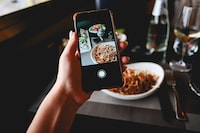A healthy diet is a balanced, well-balanced meal plan that provides nutrients needed for life including fluids, protein, vitamins, minerals and fiber. Choose foods from a wide range of food groups. Look for labels that read “whole grain” or “grains first.” Eat lean meat, poultry and fish and vary your protein choices with beans, nuts and seeds.

What’s on your plate? A quick glimpse at your social media feed might reveal a record of your most aesthetically pleasing meals.
But the amount of engagement on those photos may be smaller for snaps of healthy foods. According to a study in the journal Health Communication, people seeking to promote healthier diets might want to take a few tips from successful photos of indulgent, high-calorie meals.
To find out how food styling affects social media engagement, researchers collected nearly 54,000 photos from the Instagram accounts of 90 food influencers, then used machine learning to study everything from their color and brightness to their complexity and repetition in the images. They also measured the average calorie density of the foods pictured. Then, the researchers analyzed how much engagement each photo had generated online.
The food photos that generated the most likes and clicks shared some attributes.
Images with “arousing, warm colors such as red, orange and yellow” were more likely to generate engagement online, as were those with repetition — think, a photo of a tray of macarons as opposed to a photo of a single piece of fruit.
Photos with more feature complexity, which the researchers defined as richness in elements and perceptual detail, were also more likely to generate likes and comments.
In contrast, photos with more compositional complexity, in which visual elements clustered in a particular segment of the photo, generated less engagement. Images that were brighter and more colorful than average also got fewer likes and comments.
The more calorie-dense a food image was, the more likely it was to get lots of likes and comments, the researchers found.
That may seem like bad news for those trying to promote healthy foods online. But the researchers pointed out that the effects of visual aesthetics were more pronounced for the low-calorie images, suggesting that a few simple tweaks could make images of even healthy foods more palatable to social media users.
“There are some neurological studies that show as people visually process high-calorie meals, they process them faster than low-calorie images,” said Muna Sharma, a data scientist who was a co-author of the study while a PhD student at the University of Georgia’s College of Family and Consumer Sciences, in a news release. “So, when they are looking at a low-calorie image, they give more attention to all of these visual features. That means that if you want to draw people’s attention to these lower-calorie foods, you have to take care to highlight specific factors.”
Including warmer colors, repetitive features and showcasing foods on a clean background could help boost engagement for lower-calorie foods, she says — and perhaps help healthy foods trend.
Source: washingtonpost.com





















Add comment